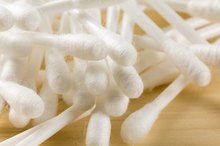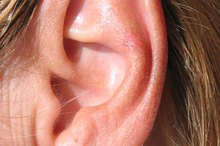Baking Soda & Water for Ear Wax
Many people view ear wax as a mere annoyance, but it actually plays an important role in protecting your hearing. Produced by your ceruminous glands, ear wax serves to keep bacteria and foreign particles from entering your ears. In certain instances, you can use baking soda and water to remove ear wax buildup, but make sure you practice basic ear-cleaning protocol to minimize possible damage to your ears.
If you are experiencing serious medical symptoms, seek emergency treatment immediately.
The Facts
According to the American Academy of Otolaryngology-Head and Neck Surgery (AAOHNS), ear wax forms in the outer one-third of your ear canal 1. Normally, this wax gradually works its way to the outer section of your ear for easy removal with a clean tissue or cloth. However, ear wax may build up in your ear canals for a variety of reasons, including unusually shaped ear canals, attempting to clean your ears with sharp objects (such as pen caps or Q-tips) and physical barriers (such as hearing aids) placed in the ears. As it builds up, the wax hardens and may become difficult to dislodge without the use of a softening agent.
Baking Soda
Waterpik Ear Wax Removal
Learn More
Commonly called sodium bicarbonate, baking soda is a naturally produced chemical compound in the form of a white powder. According to the American Academy of Family Physicians (AAFP), a water-based solution that contains 10 percent sodium bicarbonate provides an effective solution for softening compacted cerumen, especially in children 2. Commonly used for baking and household cleaning, baking soda is an inexpensive household item generally found in the baking aisle of grocery stores.
Symptoms
Pay attention to your ears to help determine whether you may want to use baking soda and water to soften the wax. One of the most common symptoms of compacted cerumen is the gradual loss of hearing. According to the National Institutes of Health, other symptoms that may indicate excess ear wax include ringing in the ears (tinnitus), earaches and a sensation of fullness in the ear 3.
Procedure
Smelly Ear Wax
Learn More
Use a baking powder and water solution alone or in combination with water irrigation to soften hardened ear wax. The University of Oregon Health Center suggests that you dissolve ½ tsp. of baking soda in 2 oz. of warm water, putting the liquid blend in a dropper bottle for convenience. Drip several drops of the baking soda solution in the affected ear at least once daily for 3 to 14 days to soften the wax, as recommended by the AAFP. If you opt to use water irrigation, as well, spray the water gently into the ear with a rubber bulb syringe about 15 to 30 minutes after one of the baking soda treatments.
- Use a baking powder and water solution alone or in combination with water irrigation to soften hardened ear wax.
- If you opt to use water irrigation, as well, spray the water gently into the ear with a rubber bulb syringe about 15 to 30 minutes after one of the baking soda treatments.
Considerations
Avoid using baking soda and water for ear wax if you have a perforated ear drum. If you or your child experience severe ear pain or show signs of unusual ear drainage with compacted cerumen, make an appointment with your primary care doctor before attempting to use baking soda and water to soften the wax. Never attempt to remove the softened wax by pushing a cotton swab into the ear canal; doing so may shove the wax farther back into the canal, which could lead to more serious problems, such as an ear infection or a perforated ear drum.
Related Articles
References
- American Academy of Otolaryngology-Head and Neck Surgery: Earwax
- American Academy of Family Physicians: Cerumen Impaction
- National Institutes of Health: Wax Blockage
- National Center for Biotechnology Information. PubChem. Compound Summary for CID 516892, Sodium bicarbonate.
- Hadzic M, Eckstein ML, Schugardt M. The impact of sodium bicarbonate on performance in response to exercise duration in athletes: A systematic review. J Sports Sci Med. 2019;18(2):271-281
- Ciancio SG. Baking soda dentifrices and oral health. J Am Dent Assoc. 2017;148(11S):S1-S3. doi:10.1016/j.adaj.2017.09.009
- Birt D, From L, Main J. Diagnosis and management of long-standing benign oral ulceration. Laryngoscope. 1980 May;90(5 Pt 1):758-68. PMID: 6990140.
- American College of Gastroenterology. Acid reflux.
- Hughes A, Brown A, Valento M. Hemorrhagic encephalopathy from acute baking soda ingestion. West J Emerg Med. 2016;17(5):619-22. doi:10.5811/westjem2016.6.30713
- Al-Abri SA, Olson KR. Baking soda can settle the stomach but upset the heart: Case files of the Medical Toxicology Fellowship at the University of California, San Francisco. J Med Toxicol. 2013;9(3):255-8. doi:10.1007/s13181-013-0300-4
- Krustrup P, Ermidis G, Mohr M. Sodium bicarbonate intake improves high-intensity intermittent exercise performance in trained young men. J Int Soc Sports Nutr. 2015;12:25. doi:10.1186/s12970-015-0087-6
- McNaughton LR, Siegler J, Midgley A. Ergogenic effects of sodium bicarbonate. Curr Sports Med Rep. 2008;7(4):230-6. doi:10.1249/JSR.0b013e31817ef530
- de Brito-Ashurst I, Varagunam M, Raftery MJ, Yaqoob MM. Bicarbonate supplementation slows progression of CKD and improves nutritional status. J Am Soc Nephrol. 2009;20(9):2075-84. doi:10.1681/ASN.2008111205
- Yang M, Zhong X, Yuan Y. Does baking soda function as a magic bullet for patients with cancer? A mini review. Integr Cancer Ther. 2020;19:1534735420922579. doi:10.1177/153473542092257
- Yang T, Doherty J, Zhao B, Kinchla AJ, Clark JM, He L. Effectiveness of commercial and homemade washing agents in removing pesticide residues on and in apples. J Agric Food Chem. 2017;65(44):9744-9752. doi:10.1021/acs.jafc.7b03118
- Qamaruz-Zaman N, Kun Y, Rosli RN. Preliminary observation on the effect of baking soda volume on controlling odour from discarded organic waste. Waste Manag. 2015;35:187-90. doi:10.1016/j.wasman.2014.09.017
- Al-Abri SA, Kearney T. Baking soda misuse as a home remedy: case experience of the California Poison Control System. J Clin Pharm Ther. 2014;39(1):73-7. doi:10.1111/jcpt.12113
- Di Iorio BR, Bellasi A, Raphael KL, Santoro D, Aucella F, Garofano L, Ceccarelli M, Di Lullo L, Capolongo G, Di Iorio M, Guastaferro P, Capasso G; UBI Study Group. Treatment of metabolic acidosis with sodium bicarbonate delays progression of chronic kidney disease: the UBI Study. J Nephrol. 2019;32(6):989-1001. doi:10.1007/s40620-019-00656-5
Writer Bio
Regan Hennessy has been writing professionally for 11 years. A copywriter and certified teacher, Hennessy specializes in the areas of parenting, health, education, agriculture and personal finance. She has produced content for various websites and graduated from Lycoming College with a Bachelor of Arts in English.









